
An artist's sketch of the proposed Titanic Signature Project, in Belfast, Northern Ireland.
To grasp the extent of Belfast's tourism appeal during the three decades of the "Troubles," one only had to visit the Europa. Its status as the world's most bombed hotel underlined the fact that, for over 30 years, Northern Ireland's capital was a tourism desert. Today, Belfast's hostelries are packed with visitors as the city reaps the rewards of political stability. But as Northern Ireland's politics change for the better, Belfast is going through an image crisis. No longer defined by bomb blasts and sectarian strife, the city is reaching for new, peaceful symbols. And it's settled on a rather unlikely choice. Two clues: Celine Dion and an iceberg.
To the uninformed, history's most famous maritime disaster may seem an odd choice for a city looking to put its tragic past behind it, but Belfast stakes a strong claim to the Titanic. After all, it was in the Harland and Wolff shipyard on the city's Queen's Island that the iconic liner was designed, built and launched. And the now rusting shipyard is the proposed site of the "Titanic Quarter," a shiny new residential and business district on the edge of Belfast Lough. The 185-acre development is the biggest regeneration project in Northern Ireland's history and would be the largest waterfront redevelopment in Europe. Its centerpiece would be the Titanic Signature Project (TSP), a tourist facility dedicated to the ship's construction. Developers estimate the TSP will draw 400,000 visitors each year, which would make it Northern Ireland's most popular urban attraction.
The memory of the ill-fated ship is being asked to do more than bring in tourists, however. "It's all to do with breaking down barriers", says Brian Ambrose, Chairman of the Titanic Foundation, the company overseeing the TSP. "We want to change Belfast's image abroad with a landmark building, but also restore local pride." The Titanic Quarter's promotional literature describes the ship as the pinnacle moment of Belfast's industrial heyday — when it was launched in 1911, it was the largest moveable man-made object on the planet. The fact that this achievement was soon eclipsed by tragedy — the elephant in the room of this $3 billion development — has little place in the Titanic Quarter's rendering of the tale. "She was alright when she left here," reads one of the T-shirts for sale on the Titanic Trail boat cruise.
"For decades, the Titanic was a taboo topic", says Una Reilly, chairman of the Belfast Titanic Society, during a tour of the TSP site. "There was almost a sense of shame that it had been built here." But Reilly, whose great-grandfather worked as a cabinetmaker on the Titanic, is convinced that this ghost from Belfast's past is the perfect vehicle for the city's future. "The Titanic was at the cutting edge of technology when she was built. That's the kind of innovation Belfast should be striving for today".
But winning acceptance of Titanic as a badge of honor for all of Belfast faces an all-too-familiar hurdle. Few symbols are regarded as neutral in a city where neighborhoods, education and even sports are still segregated along Catholic-Protestant lines. Many Catholics see Belfast shipbuilding as an exclusively Protestant industry, in which discrimination was endemic. In one notorious incident back in July 1920, a Protestant mob drove Catholic employees out of the Harland and Wolff shipyard, beating them with sticks. Fifty years later, as Northern Ireland's Troubles were dawning, only 400 of the shipyard's 10,000 employees were Catholic. That's one blot on the Titanic legacy developers know can't be erased by a T-shirt.
It's the perceived airbrushing of the less heroic elements of the Titanic story that has left some locals unconvinced. For them, the Titanic Quarter is as much a developers' dream as a civic endeavor. "The Titanic is of such importance to the city and to Western culture," says Belfast-born Bill Neill, Professor of Spatial Planning at Aberdeen University, "but this vapid project represents a whitewashed history. [The developers] are inventing a past that never existed".
"We have to say more than just 'the Troubles are over,'" contends Titanic Foundation Chairman Brian Ambrose. "The Titanic is a worldwide brand with a unique link to Belfast. We're not going to scale this project down." But before the project sets sail, it has some tricky financial waters to navigate. The Signature Project's bid for just under $50m in funding from the U.K. National Lottery was beaten out by rival contenders last October. If the project is to be completed by the 2011 deadline — the centenary of the Titanic's launch — those missing millions, just under a third of the TSP's estimated cost, will have to be gathered at a rate of knots, largely from Northern Ireland's private sector. "Belfast people can be hard to impress", says Ambrose. "But the TSP will rival the best attractions in the world. After 30 years of bad press, that's a huge step for this city."
